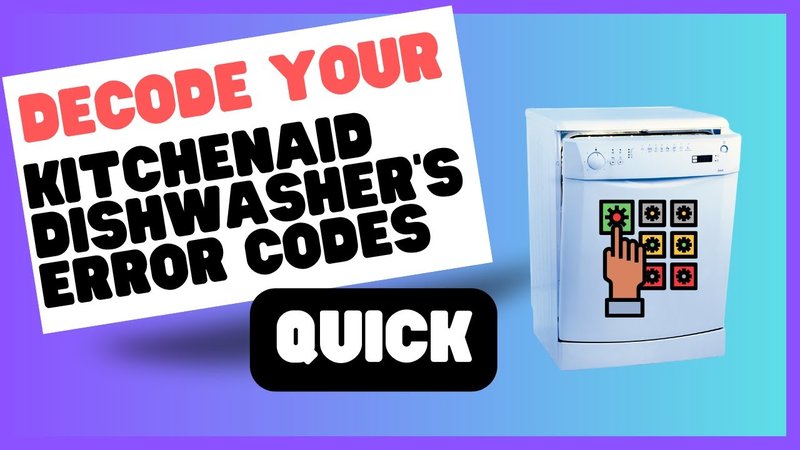
Error codes are like the language your dishwasher speaks when it’s trying to tell you something’s amiss. The E3 error code on your KitchenAid dishwasher usually means there’s an issue with the heating element or the water temperature. Simply put, the machine isn’t heating the water properly, which could be due to a malfunction or an issue with the thermostat. So, can you ignore it? Think about it like this: if your car’s check engine light popped on, would you keep driving without a second thought? Probably not. Similarly, ignoring the E3 code might lead to bigger problems down the road.
Understanding the Importance of the E3 Error Code
Now, you might be asking yourself, “Why can’t I just ignore this code? My dishes seem clean enough.” While it might be tempting to let it slide, it’s crucial to understand what the error signifies. The E3 code indicates that your dishwasher is struggling to heat the water to the necessary temperature for effective cleaning. In simpler terms, it’s like trying to wash greasy pans in cold water—it might work, but it won’t be very effective.
The primary role of heated water is to help break down grease and food residues, ensuring your dishes come out sparkling clean. Without proper heating, not only is cleanliness compromised, but it might also affect the drying process. Dishes that aren’t dried properly can become breeding grounds for bacteria, which is the last thing you want on items you eat from daily. Ignoring this error could lead to health risks and unsatisfactory dishwasher performance, potentially increasing your workload as you might find yourself rewashing dishes by hand.
Additionally, ignoring the E3 error might shorten your appliance’s lifespan. The longer the problem persists, the more strain it puts on your dishwasher’s other components, leading to more significant and expensive damages over time. It could be like ignoring a leaky roof—it won’t just fix itself, and eventually, the consequences could be costly. Therefore, addressing the E3 error promptly can save you both time and money in the long run.
Causes Behind the KitchenAid E3 Error Code
Let’s dive a bit deeper into why this error occurs in the first place. Understanding the root cause can often point you in the direction of a solution. One of the most common reasons for the E3 error is a faulty heating element. The heating element is responsible for raising the water to the desired temperature. If it’s not working correctly, the dishwasher can’t perform efficiently, similar to how a broken oven can’t bake your favorite cookies.
Another potential culprit might be the thermostat. The thermostat is like the dishwasher’s brain, monitoring and regulating the water temperature. If it malfunctions, it might give false readings, making the appliance think the water is hotter than it actually is. This disconnect between perception and reality leads to ineffective cleaning cycles.
Clogs or blockages within the machine can also trigger an E3 error. If the water can’t circulate properly due to debris, it might not reach the heating element effectively, thus not reaching the required temperature. Think of it as a clogged artery, preventing nutrients (or in this case, heat) from reaching their destination. Each of these issues requires different solutions, from replacing the faulty parts to clearing blockages, ensuring your dishwasher runs smoothly.
Steps to Resolve the E3 Error Code
If you’re feeling adventurous and want to tackle this issue yourself, there are some steps you can take to try and remedy the situation. Firstly, unplug your dishwasher before performing any maintenance to ensure safety. Once you’re ready, check the heating element for any visible damage. If it looks burnt out or broken, replacing it might be necessary. You can often find replacement parts and guides online, turning you into a weekend repair hero.
Next, take a look at the thermostat. It’s a bit trickier since it involves more technical know-how, but a multimeter can help you test if it’s functioning properly. No reading or a consistently wrong one could indicate it needs replacing. If you’re unsure, don’t hesitate to call a professional. They can diagnose the issue more accurately and get your dishwasher back in working order.
Lastly, check for any blockages. Remove the dishwasher’s spray arms and filters, cleaning them thoroughly. This process is akin to unclogging a showerhead to improve water flow. By ensuring that water can circulate unrestricted, you reduce the likelihood of errors, allowing the machine to heat and clean effectively.
In conclusion, while the E3 error might seem like a minor hiccup, paying attention to it can prevent bigger issues later on. By understanding and addressing these errors promptly, you contribute to your appliance’s longevity and efficiency. Regular maintenance, like cleaning filters and checking parts, can prevent many problems before they arise, keeping your dishwasher—and your dishes—in tip-top shape.